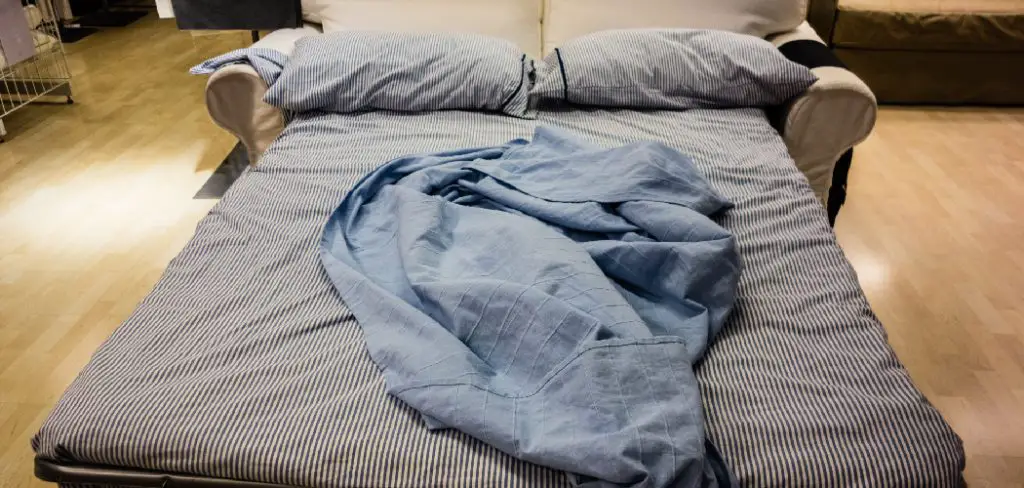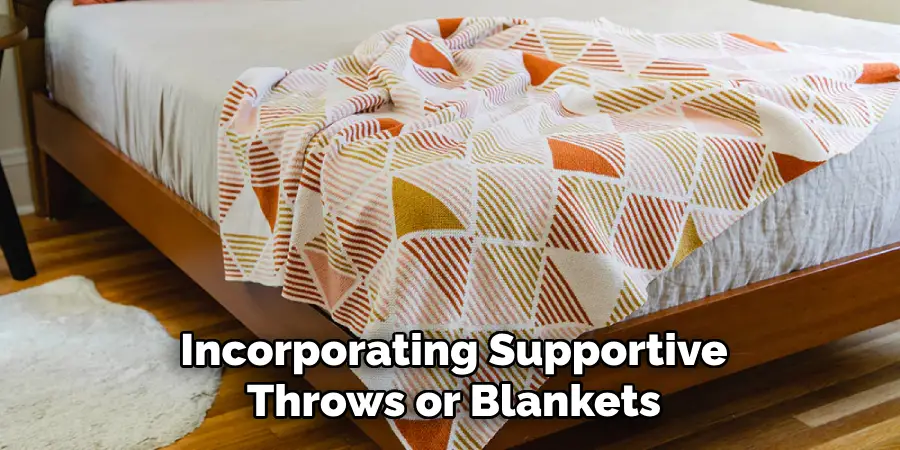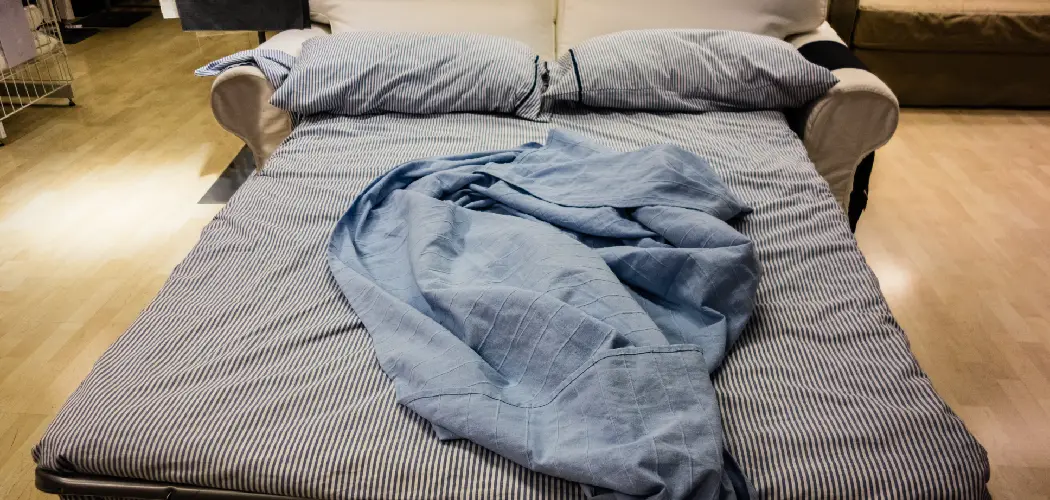Are you looking for ways to make your sofa bed more comfortable? Look no further! In this guide, we’ll discuss some simple and practical tips on how to make a sofa bed comfortable.
Regarding versatile home furniture, sofa beds are a popular choice for many households. However, despite their practicality, they often have a reputation for being uncomfortable. Whether it’s the slim mattress or the awkward support bars, sleeping on a sofa bed can sometimes feel less than ideal. Fortunately, with the proper techniques and thoughtful enhancements, you can transform your sofa bed into a cozy and inviting space for guests or your use.

This guide will walk you through the essential steps to ensure your sofa bed offers a restful and comfortable night’s sleep.
What Will You Need?
Before we dive into the tips, let’s take a look at some of the items you may need to make your sofa bed more comfortable:
- A mattress topper or foam pad
- Extra blankets and pillows
- Fitted sheet or mattress protector
- Comfortable bedding (blankets, sheets, duvet)
With these basic supplies, you can quickly transform your sofa bed into a haven of comfort and relaxation.
10 Easy Steps on How to Make a Sofa Bed Comfortable
Step 1: Upgrade Your Mattress
One of the most effective ways to enhance the comfort of a sofa bed is to upgrade the mattress. Most sofa beds come with thin and unsupportive mattresses that can lead to an uncomfortable sleeping experience. Consider replacing the existing mattress with a higher-quality option explicitly designed for sofa beds. Look for a memory foam or gel-infused mattress that provides better support and conforms to the body’s shape, which will help alleviate pressure points and improve sleep quality. If replacing the mattress entirely is not feasible, adding a mattress topper is a cost-effective alternative.

A good quality memory foam topper can significantly add comfort by providing additional cushioning and support. Ensure that any new mattress or topper is compatible with your sofa bed’s dimensions to fit properly when folding.
Step 2: Add a Mattress Topper
If a full mattress replacement isn’t an option, consider investing in a quality mattress topper. A mattress topper can add an extra cushioning layer, providing comfort and support. Memory foam or latex toppers are particularly effective in enhancing the softness and supportiveness of a sofa bed mattress. These toppers can reduce pressure points and increase overall sleeping comfort by evenly distributing weight. Ensure the topper fits nicely on the existing sofa bed mattress and secure it with a fitted sheet to keep it from shifting during the night.
Step 3: Layer on the Bedding
Layering on the bedding is essential to enhance the comfort of your sofa bed further. Start by choosing high-quality sheets, such as cotton or bamboo, that feel soft against the skin. These materials are breathable and can help regulate body temperature, ensuring a comfortable sleep regardless of the season. Once the sheets are in place, layer on additional blankets or a duvet to provide warmth and coziness. Opt for materials like down or a down alternative for a plush and luxurious feel.
Adding a quilt or throw blanket can also give a decorative touch while offering an extra layer of warmth. Don’t forget to include a selection of pillows in varying sizes and firmness levels. By providing both firm and soft options, guests can select their preferred neck and head support level. Consider including a body pillow for additional comfort, primarily if the sofa bed is a regular resting place.

Step 4: Address Support Bars
One common complaint with sofa beds is the discomfort caused by the support bars beneath the mattress. These bars can create uncomfortable pressure points, disrupting a good night’s sleep. Fortunately, several strategies can help mitigate this issue. Firstly, consider using a folded blanket or quilt as a buffer between the mattress and the support bars. This layer of padding can help cushion the pressure from the bars and create a more even surface for sleeping.
Additionally, a dense foam pad placed directly over the bars can serve as another solution, providing robust support while minimizing the impact of the bars. You might look into custom-fit solutions such as sagging support boards for a more permanent fix. These wooden or plastic boards are designed to create a smoother sleeping surface by distributing the body weight more evenly across the mattress.
Step 5: Adjust the Frame
Another way to increase the comfort level of a sofa bed is to ensure the frame is adjusted and set up correctly. With frequent use, the frame of a sofa bed can become loose or misaligned, affecting the mattress’s overall support. Regularly inspect the frame for any loose screws or bolts, and tighten them as needed to maintain stability. Additionally, check for any signs of wear or damage that might impact the frame’s ability to support the mattress and its occupants fully.
If possible, tweak the alignment of the bed to ensure that it opens and closes smoothly, reducing any uneven areas that might cause discomfort while sleeping. Maintaining the frame in good condition not only enhances comfort but also prolongs the life of the sofa bed itself.
Step 6: Add Supportive Throws
Incorporating supportive throws or blankets can add an immediate layer of coziness and warmth to your sofa bed, providing additional comfort. Soft, thick throws can serve as extra padding and can be tailored to fit the personal preferences of the sleeper. Position a supportive throw over any existing bedding layer to enhance overall comfort and ensure a snug, restful sleep. Opt for materials like fleece or knit, which offer warmth and softness.

Experiment with rolling the throw into a bolster shape for added back or leg support, depending on individual needs. Such versatile pieces can be easily stored and adjusted, making them a practical addition to your comfortable sofa bed setup.
Step 7: Increase Cushioning with Pillows
Pillows are not only key to sofa bed comfort but also add style and versatility to your setup. Start by selecting a variety of pillows in different sizes and levels of firmness. This variety allows guests to customize their sleep experience by choosing the right neck, head, and back support combination. Incorporate both soft and firm options to cater to different sleeping preferences. Furthermore, adding decorative pillows can enhance the aesthetic appeal of the sofa bed, making it visually inviting.
A body pillow is also an excellent option for additional lumbar or leg support, helping to alleviate pressure points. Arrange these pillows to maximize comfort when the sofa bed is open and closed, ensuring that they are within easy reach for adjustment during the night.
Step 8: Ensure Proper Ventilation
To maintain a fresh and comfortable sleeping environment, proper ventilation is critical. Sofa beds, especially those used regularly, can accumulate odors and humidity from nightly use. Ensure that the room housing the sofa bed is well-ventilated by periodically opening windows or using a fan or air purifier to circulate air. This circulation helps to reduce moisture and prevent the build-up of stale odors. Additionally, consider airing out the sofa bed mattress occasionally by leaving it unfolded during the day, allowing fresh air to penetrate the materials. Using breathable mattress covers can further protect against moisture retention while keeping the mattress feeling fresh and new.
Step 9: Refresh Bedding Regularly
To ensure ongoing comfort and hygiene, refreshing the bedding on your sofa bed is essential. Regularly washing sheets, pillowcases, and blankets keeps the sleeping environment clean and inviting. Opt for materials that can withstand frequent laundering without losing softness or shape. Additionally, consider investing in extra bedding sets to make the task easier and quick to switch when necessary. It’s also a good idea to occasionally launder the mattress cover and air out pillows to prevent dust buildup and allergens. Maintaining clean bedding contributes to a comfortable and healthy night’s sleep for anyone using the sofa bed.

Step 10: Enhance Noise Reduction
A peaceful environment is crucial for a restful night’s sleep, especially when using a sofa bed in shared or high-traffic areas. To minimize external noise and disturbances, consider incorporating noise-canceling solutions. Thick curtains or heavy drapes can help absorb sound, muffling noises from outside or other parts of the home. Additionally, a sound machine or white noise app can create a consistent and soothing background sound, helping to drown out sudden disruptions. Earplugs are another effective measure, offering a simple yet potent way to block noise. By addressing potential noise issues, you can significantly enhance the overall comfort and sleep quality of your sofa bed.
By following these steps, you can maximize the comfort level of your sofa bed and provide a welcoming and restful sleeping experience for any guests.
Conclusion
In conclusion, how to make a sofa bed comfortable involves a series of thoughtful adjustments and enhancements.
Investing in a high-quality mattress topper and custom-fit support solutions can significantly improve the sleep surface. Regular maintenance of the frame ensures stability and alignment while adding throws, pillows, and additional bedding layers enhances coziness and support. Proper ventilation and regular bedding refreshment maintain hygiene and freshness, and implementing noise reduction techniques can ensure a tranquil rest.
These combined efforts can transform a sofa bed into a comfortable and inviting alternative for guests, ensuring they enjoy a restful night’s sleep.
About
Angela is the chief editor of Indoorense. She began her career as an interior designer before applying her strategic and creative passion to lifestyle and home.
She has close to 15 years of experience in creative writing and online content strategy for housekeeping and cleaning,home decorations as well as other efforts.
She loves her job and has the privilege of working with an extraordinary team. She lives with her husband, two sons, and daughter in Petersburg. When she’s not busy working she spent time with her family.

